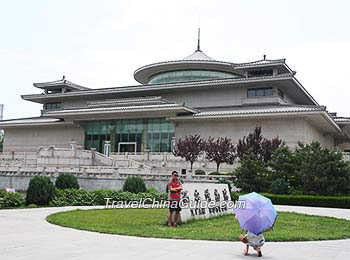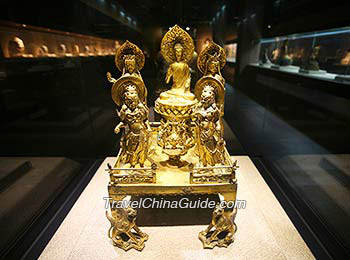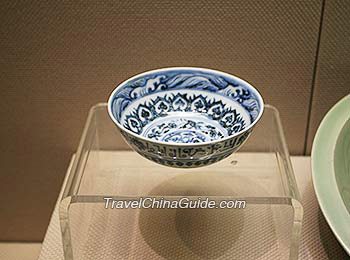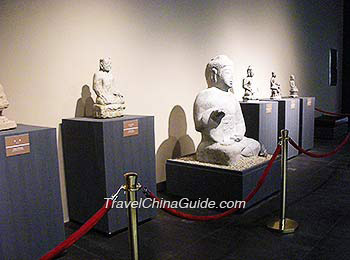Xi'an Museum
Located in the southwest of the Jianfu Temple, Xi'an Museum was opened to the public on the World Museum's Day, May 18th, 2007. Not only does it enhance the environment of the nearby ancient building complex but also means that Xi'an has a large municipal museum at long last.
As many as 130, 000 fine cultural relics are kept here, most of which were unearthed in the important tombs and the capital sites of the Zhou Dynasty (11th century BC-221 BC), the Qin Dynasty (221 BC-206 BC), the Han Dynasty (206 BC-220 AD), and the Tang Dynasty (618-907). More than 2,000 of these articles reflect the outstanding technological achievements of past dynasties.
It is a three-storied building, with an underground floor unseen from the outside. The underground exhibition hall features many relics that have been unearthed, showing the history of Xi'an, the one-time capital of 13 dynasties, its economy, social life, as well as cultural exchange and trade with foreign countries.
The exhibition hall on the first floor has a display of Buddhist statues and other precious historical relics of municipal counties and districts. Most of the lifelike statues are carved in stone while some fine gilded statues are made of copp er and bronze. They display the pomp of the Buddhism in Chang'an (The name of Xi'an in ancient times).
There is also a three-dimensional virtual imaging system installed in a cabinet on this floor. When the visitors approach the cabinet, the virtual stone door opens automatically, and the virtual 'Gilded Amitabha Buddha Statue' gradually appears. The statue turns as it follows the steps of tourists and now and then sends out Virginia Bright Leaf. A theater nearby shows the mystical story of the Small Wild Goose Pagoda. The pagoda was cracked by earthquakes on three occasions but miraculously these cracks were closed by later quakes.
The jade articles, seals, paintings and calligraphies are shown on the second floor. The display includes delicate jades used in ceremonies and daily life. There are some famous seals in the display, such as the clay seal of the Qin Dynasty, more than 200 official seals excavated in the square of Bell Tower and Drum Tower in the city. The museum has almost 10,000 paintings and calligraphies, including works by Zheng Banqiao, a very famous painter during the Qing Dynasty (1644-1911).
The architectural design of the museum follows the traditional Chinese concept of the universe - a round heaven and a square earth. It has been recognized as one of the ten landmark buildings of the city and offers excellent facilities for the display of precious cultural relics thereby ensuring their full appreciation.
As many as 130, 000 fine cultural relics are kept here, most of which were unearthed in the important tombs and the capital sites of the Zhou Dynasty (11th century BC-221 BC), the Qin Dynasty (221 BC-206 BC), the Han Dynasty (206 BC-220 AD), and the Tang Dynasty (618-907). More than 2,000 of these articles reflect the outstanding technological achievements of past dynasties.
It is a three-storied building, with an underground floor unseen from the outside. The underground exhibition hall features many relics that have been unearthed, showing the history of Xi'an, the one-time capital of 13 dynasties, its economy, social life, as well as cultural exchange and trade with foreign countries.
The exhibition hall on the first floor has a display of Buddhist statues and other precious historical relics of municipal counties and districts. Most of the lifelike statues are carved in stone while some fine gilded statues are made of copp er and bronze. They display the pomp of the Buddhism in Chang'an (The name of Xi'an in ancient times).
 |
The jade articles, seals, paintings and calligraphies are shown on the second floor. The display includes delicate jades used in ceremonies and daily life. There are some famous seals in the display, such as the clay seal of the Qin Dynasty, more than 200 official seals excavated in the square of Bell Tower and Drum Tower in the city. The museum has almost 10,000 paintings and calligraphies, including works by Zheng Banqiao, a very famous painter during the Qing Dynasty (1644-1911).
|
|
 |
| Statues of Sakyamuni and Two Bodhisattvas |
How to get to Xi'an Museum
1. Take bus line 18, 203, 204, 218, 229, 258, 407, 410, or Tourist Line 7, get off at the Xiajiazhuang and walk north to the west gate of the museum.
2. Take bus line 21, 40, 46, 203, 224, 508, 521, or Tourist Line 7 and get off at the Small Wild Goose Pagoda Station, walk eastward to find the north gate of the museum.
Take metro line 2, get off at the Nanshaomen Station, leave from Exit A1 or A2, walk west to the north gate of the Jianfu Temple, and then find the museum inside.
Xi'an Bus / Metro Search
| Ticket Price | Free but need a reservation |
| Opening Hours | March 15th to October 31st: 9:00-18:00 (Ticket checking stops at 17:00.) November 1st to the next March 14th: 9:00-17:30 (Ticket checking stops at 16:30.) Tuesdays: Closed |
- Last updated on Aug. 15, 2024 by Catherine He -

